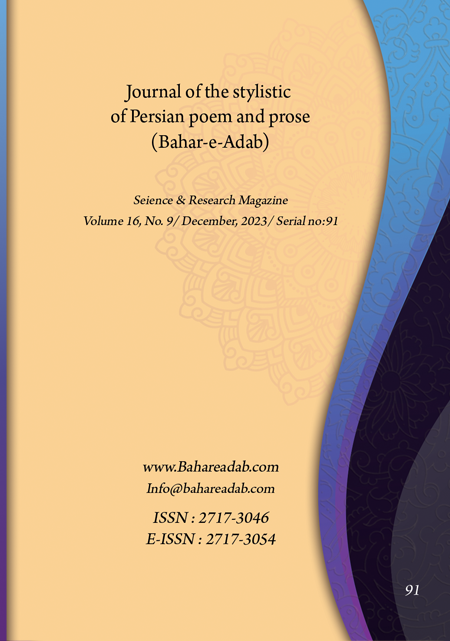- Count View : 359
- آدرس کوتاه شده مقاله: https://bahareadab.com/article_id/1547
- کد doi مقاله: Doi: 10.22034/bahareadab.2023 .16 .7105
Journal of the stylistic of Persian poem and prose
volume Number 16،
number In Volume 9،
،
issue Number 91
Symbol in modern Persian short story (stories from 1961 to 1978)
Ali Hayatbakhsh , Farhad Doroudgharian (Author in Charge), Mostafa Gorji
Abstract
BACKGROUND AND OBJECTIVES: : Persian short story in the period from 1340 to 1357, (according to the published works and the opinion of literature researchers), has seen the most "modern stories"; To the extent that this period should be considered as "modern Persian short story period". The type of worldview and expression of modern fiction writers is such that their works are often not clear and explicit, accompanied by ambiguities; For this reason, it is important for the modern writer to use different techniques for expression, one of the most important of which is the "symbolization" technique. Considering the importance of "symbol" in the modern Persian short story, especially in the period from 1340 to 1357, we have investigated and symbolically analyzed the works of four authors, representing four intellectual spectrums.
METHODOLOGY: These investigations were carried out by referring to references and books of social sciences, psychology, semiotics, symbology, etc.; During which the works of Ebrahim Golestan representing mental-psychological stories, the works of Ghazaleh Alizadeh representing mystical stories, the works of Bahram Sadeghi representing social-bitter humor stories, and the works of Ebrahim Rahbar representing urban-climate stories have been examined. ; This review includes the analysis of 7 books and 68 stories.
FINDINGS: Findings: According to the reviews, tables and analytical statistics presented in the appendix of the article, it should be said that the frequency of using "symbol" in modern short stories is wide. Basically, modern short stories, due to their brevity and ambiguities, are a suitable place for giving birth to symbols.
CONCLUSION: The more introspective the modern short story is, the higher the frequency of the symbol in it; This is why the modern mystical stories of Ghazaleh Alizadeh contain the most symbolic stories. With this reasoning, the mental and psychological stories of Ebrahim Golestan have used the symbol to a significant extent. In many works of Bahram Sadeghi, we are faced with the symbolization of the author, according to the space of the story. Ebrahim Rahbar does less symbolism in two books that have descriptive and extroverted works; But in his other work, the theme of which is the conflict with the hardships of an employee"s life in Tehran, he has used the symbol technique more.
Keyword
short story
, modern
, symbol
, Ibrahim Golestan
, Ghazaleh Alizadeh
, Bahram Sadeghi
, Ibrahim Rahbar
- Dad, Sima. (2011). Dictionary of literary terms. Fifth Edition. Tehran: Morvarid, p.216.
- Green, Wilfred and others. (1997). Basics of literary criticism. Tehran: Niloofar, p.324.
- Haddad, Hossein. (2016). The undertones of the story, the experiences of the writers of Iran and the world.2 volumes, Tehran: Scientific and Cultural, p.415
- Ja’fari, Siavash. (2015). New poetry in the scale of interpretation. Tehran: Morvarid, p.30.
- Jung, Carl Gustav. (1973). Man and his symbols. Translation: Abu Taleb Sarmi. Tehran: Amirkabir, p.23.
- Lyotard, Francois. (2008). The post-modern state, a report on knowledge. Translation: Hossein Ali Nowzari. Third edition. Tehran: Gam-e-Now, p.23.
- Mastur, Mustafa. (2000). Basics of short story. Tehran: Markaz, p.7.
- McCarthy, Rega. (2007). “Using symbols in short stories”. Translation: Kaveh Fuladi-Nasab, Rudaki Magazine, No. 18, p.28.
- Mirabdini, Hassan. (2001). Eighty years of Iranian short stories. Three volumes, Tehran: Ketab Khurshid, p.10.
- Mirsadeghi, Jamal. (2003). Fiction literature in Iran. Tehran: Amirkabir, p.12.
- Mirsadeghi, Jamal. (2012). The story world of Iran. Tehran: Eshare, p.17.
- Mirsadeghi, Jamal. (2014). How to become a storyteller? Tehran: Sokhan, p.207.
- Mirsadeghi, Jamal. (2015). Dictionary of the art of story writing, third edition. Tehran: Mahnaz book, p.116.
- Oates, Joyce Carol. (1988). The nature of short stories in short story teaching techniques. Translation and compilation: Reza Fard. First Edition. Tehran: Amirkabir, p.20.
- Payandeh, Hossein. (2010). Short story in Iran. The first volume and the second volume: realistic and naturalistic stories. Tehran: Niloofar, vol. 2, p.133.
- Pournamdarian, Taghi. (1988). Code and secret stories in Persian literature. Tehran: Scientific and Cultural, p.14.
- Rahnama, Touraj. (1974). “Critique of the blind owl”. Sokhan Journal, Volume 23, pp. 492-506.
- Reed, Ian. (1997). Short story. Translated by Farzaneh Taheri, Tehran: Markaz, p.74.
- Sadr, Ro’ya. (2001). “Humor and empty flasks”. Book Month of Literature and Philosophy, No. 44, p.59.
- Seyed Hosseini, Reza. (1997). Literary schools. Third edition. Tehran: Negah, p.539.
- Shamisa, Sirus. (2004). Expression. Sixth edition. Tehran: Mitra, p.264.
- Shamisa, Sirus. (2008). The culture of gestures. Tehran: Mitra, p.217.
- Shiri, Ghahreman. (2015). The magic of exorcism, review and identification of Hoshang Golshiri. Tehran: Vara, p.267.

